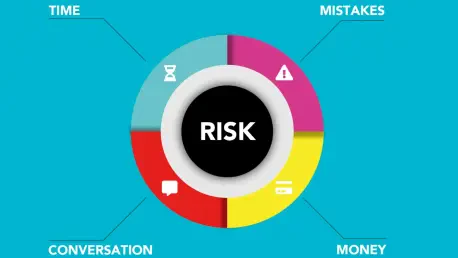In today’s volatile business environment, the complexity of risks that organizations face has grown exponentially. From supply chain disruptions to cybersecurity threats, these challenges can severely impact operations. A robust risk management strategy ensures stability by anticipating potential risks and crafting responses that allow organizations to handle them effectively. As businesses navigate these complexities, understanding and implementing best practices in risk management is more crucial than ever.
Understanding the Importance of Risk Management
Businesses are encountering increasingly multifaceted risks that threaten their operations in diverse ways. The complexity of these threats is ever-growing, making it vital for companies to adopt a structured approach to risk management. This proactive stance fosters business stability and supports sustained growth by minimizing unanticipated disruptions. Essential components addressed in this guide include risk identification, assessment, response strategies, role assignment, and monitoring systems.
Risk management provides the framework needed to navigate uncertainties effectively. By establishing a comprehensive plan, organizations safeguard themselves against unforeseen challenges and can maintain operational stability even in precarious situations. This approach facilitates decision-making processes across all levels, ensuring that strategic initiatives align with the organization’s risk tolerance and appetite.
Benefits of Effective Risk Management
Implementing a sound risk management strategy has far-reaching benefits that are pivotal for organizational success. It enhances decision-making by providing a thorough understanding of risks associated with different business strategies, aiding leaders in selecting optimal paths. Furthermore, resource optimization is achieved through focused attention on the most significant risks, directing efforts where they’re needed most.
This strategic management also ensures improved compliance with regulatory demands, as many industries mandate formal risk management protocols. By adhering to these processes, businesses not only meet necessary standards but also increase confidence among stakeholders such as customers, investors, and partners. The assurance that risk is managed expertly results in bolstered trust, improved cost controls, and uninterrupted business operations.
Best Practices for Risk Management
Adopting best practices in risk management allows businesses to effectively tackle the challenges posed by varied risks. Detailed actionable steps include systematic risk identification, evaluation frameworks, development of response strategies, and precise role assignments. Real-world examples highlight these best practices in action.
Establishing a Risk Identification Process
A thorough risk identification process is imperative in safeguarding business interests across diverse areas. Systems should be in place to recognize potential risks, covering operational, financial, and technological aspects of the organization. Continuous reviews ensure that new risks are consistently addressed, adapting to evolving conditions.
Case Study: Successful Risk Identification in the Tech Industry
Leading tech companies have excelled in identifying risks through innovative approaches, addressing vulnerabilities in cybersecurity, regulatory changes, and market shifts. Their proactive stance prevents disruptions by continuously updating their frameworks to anticipate emerging threats.
Implementing a Risk Assessment and Prioritization Framework
Evaluating and ranking identified risks based on impact and likelihood is essential. Creating standardized assessment metrics ensures consistency and clarity in understanding which risks require priority attention. Both quantitative and qualitative factors contribute to comprehensive evaluations.
Example: Risk Assessment Strategies in Financial Services
Financial service providers adeptly use risk assessment frameworks to evaluate complex risks stemming from market volatility and regulatory pressures. By employing clear metrics, they manage to prioritize threats effectively, safeguarding their interests.
Developing Risk Response Strategies
Risk response strategies are vital for addressing identified threats. Methods such as risk avoidance, transfer, mitigation, and acceptance provide varied approaches to handling risks according to organizational preferences and capabilities.
Case Study: Risk Mitigation Tactics in Manufacturing
Manufacturers utilize targeted risk mitigation strategies, such as enhanced safety protocols and process improvements, to reduce operational risks. This proactive approach ensures continuity amid potential disruptions, minimizing impacts on production and supply chains.
Assigning Roles and Responsibilities
Clearly defined roles and responsibilities ensure every participant in risk management is accountable. This clarity fosters efficiency in risk monitoring and execution of response plans, ensuring consistent efforts toward managing organizational risks.
Example: Role Assignment in Risk Management Teams
Successful companies designate specific roles within risk management teams, empowering individuals to oversee and act on threats effectively. This well-orchestrated assignment of duties ensures comprehensive coverage and accountability.
Monitoring and Reporting Risk Management Efforts
Regular monitoring and accurate reporting are vital for ongoing risk management success. Effective communication channels and measurement of risk activities keep stakeholders informed, enabling timely responses to emerging concerns.
Case Study: Effective Risk Reporting in Healthcare
Healthcare organizations adeptly monitor and report risk management efforts, employing timely updates and detailed reports to keep stakeholders informed. This approach ensures regulatory compliance and enhances trust among patients and partners.
Conclusive Thoughts and Recommendations
The journey through risk management best practices reveals crucial strategies that businesses can tailor to their specific needs. Organizations are encouraged to adopt these practices to mitigate risks, ensuring stability and growth. The benefits are extensive, from improved decision-making to enhanced compliance and operational efficiency.
A robust risk management strategy is indispensable across industries, benefiting companies facing ever-evolving challenges. By fostering collaboration, consistent review processes, and adaptive responses, businesses can ensure their preparedness for risk management challenges now and into the future.









